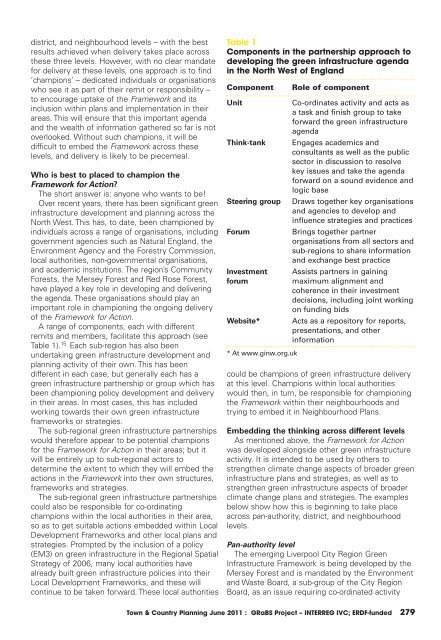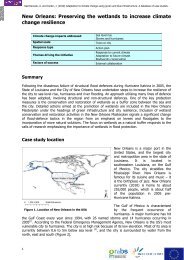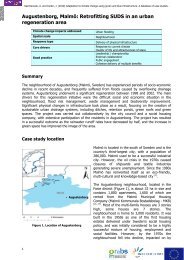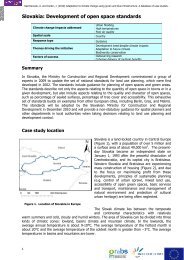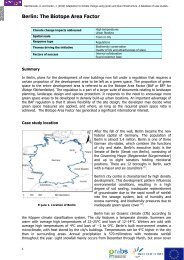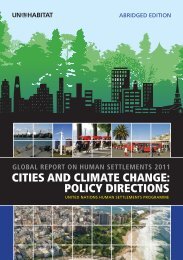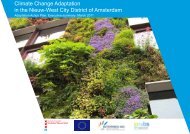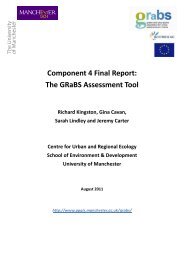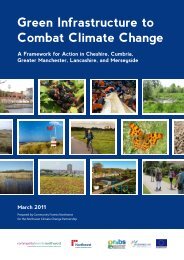Download - GRaBS
Download - GRaBS
Download - GRaBS
You also want an ePaper? Increase the reach of your titles
YUMPU automatically turns print PDFs into web optimized ePapers that Google loves.
district, and neighbourhood levels – with the best<br />
results achieved when delivery takes place across<br />
these three levels. However, with no clear mandate<br />
for delivery at these levels, one approach is to find<br />
‘champions’ – dedicated individuals or organisations<br />
who see it as part of their remit or responsibility –<br />
to encourage uptake of the Framework and its<br />
inclusion within plans and implementation in their<br />
areas. This will ensure that this important agenda<br />
and the wealth of information gathered so far is not<br />
overlooked. Without such champions, it will be<br />
difficult to embed the Framework across these<br />
levels, and delivery is likely to be piecemeal.<br />
Who is best to placed to champion the<br />
Framework for Action?<br />
The short answer is: anyone who wants to be!<br />
Over recent years, there has been significant green<br />
infrastructure development and planning across the<br />
North West. This has, to date, been championed by<br />
individuals across a range of organisations, including<br />
government agencies such as Natural England, the<br />
Environment Agency and the Forestry Commission,<br />
local authorities, non-governmental organisations,<br />
and academic institutions. The region’s Community<br />
Forests, the Mersey Forest and Red Rose Forest,<br />
have played a key role in developing and delivering<br />
the agenda. These organisations should play an<br />
important role in championing the ongoing delivery<br />
of the Framework for Action.<br />
A range of components, each with different<br />
remits and members, facilitate this approach (see<br />
Table 1). 15 Each sub-region has also been<br />
undertaking green infrastructure development and<br />
planning activity of their own. This has been<br />
different in each case, but generally each has a<br />
green infrastructure partnership or group which has<br />
been championing policy development and delivery<br />
in their areas. In most cases, this has included<br />
working towards their own green infrastructure<br />
frameworks or strategies.<br />
The sub-regional green infrastructure partnerships<br />
would therefore appear to be potential champions<br />
for the Framework for Action in their areas; but it<br />
will be entirely up to sub-regional actors to<br />
determine the extent to which they will embed the<br />
actions in the Framework into their own structures,<br />
frameworks and strategies.<br />
The sub-regional green infrastructure partnerships<br />
could also be responsible for co-ordinating<br />
champions within the local authorities in their area,<br />
so as to get suitable actions embedded within Local<br />
Development Frameworks and other local plans and<br />
strategies. Prompted by the inclusion of a policy<br />
(EM3) on green infrastructure in the Regional Spatial<br />
Strategy of 2006, many local authorities have<br />
already built green infrastructure policies into their<br />
Local Development Frameworks, and these will<br />
continue to be taken forward. These local authorities<br />
Table 1<br />
Components in the partnership approach to<br />
developing the green infrastructure agenda<br />
in the North West of England<br />
Component<br />
Unit<br />
Think-tank<br />
Steering group<br />
Forum<br />
Investment<br />
forum<br />
Website*<br />
* At www.ginw.org.uk<br />
Role of component<br />
Co-ordinates activity and acts as<br />
a task and finish group to take<br />
forward the green infrastructure<br />
agenda<br />
Engages academics and<br />
consultants as well as the public<br />
sector in discussion to resolve<br />
key issues and take the agenda<br />
forward on a sound evidence and<br />
logic base<br />
Draws together key organisations<br />
and agencies to develop and<br />
influence strategies and practices<br />
Brings together partner<br />
organisations from all sectors and<br />
sub-regions to share information<br />
and exchange best practice<br />
Assists partners in gaining<br />
maximum alignment and<br />
coherence in their investment<br />
decisions, including joint working<br />
on funding bids<br />
Acts as a repository for reports,<br />
presentations, and other<br />
information<br />
could be champions of green infrastructure delivery<br />
at this level. Champions within local authorities<br />
would then, in turn, be responsible for championing<br />
the Framework within their neighbourhoods and<br />
trying to embed it in Neighbourhood Plans.<br />
Embedding the thinking across different levels<br />
As mentioned above, the Framework for Action<br />
was developed alongside other green infrastructure<br />
activity. It is intended to be used by others to<br />
strengthen climate change aspects of broader green<br />
infrastructure plans and strategies, as well as to<br />
strengthen green infrastructure aspects of broader<br />
climate change plans and strategies. The examples<br />
below show how this is beginning to take place<br />
across pan-authority, district, and neighbourhood<br />
levels.<br />
Pan-authority level<br />
The emerging Liverpool City Region Green<br />
Infrastructure Framework is being developed by the<br />
Mersey Forest and is mandated by the Environment<br />
and Waste Board, a sub-group of the City Region<br />
Board, as an issue requiring co-ordinated activity<br />
Town & Country Planning June 2011 : <strong>GRaBS</strong> Project – INTERREG IVC; ERDF-funded 279


